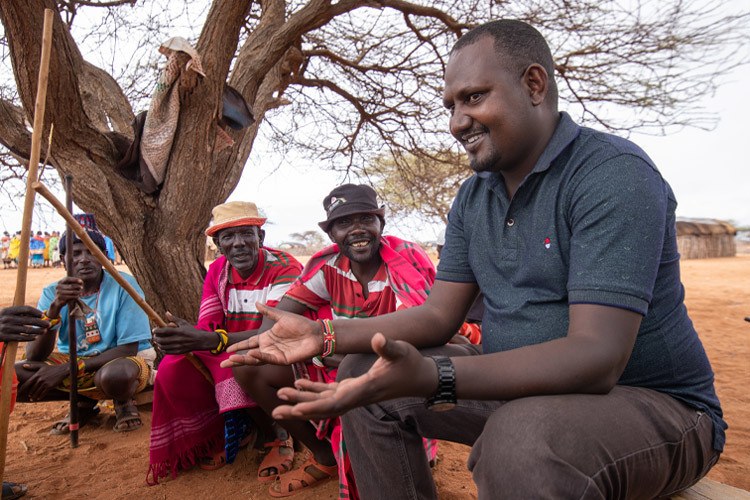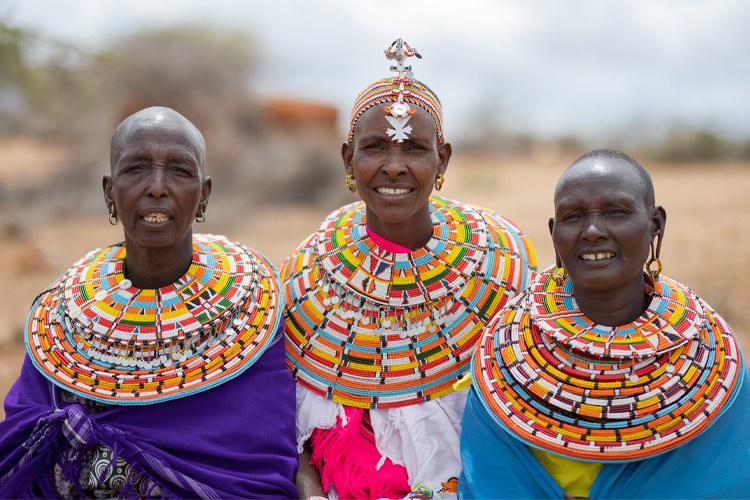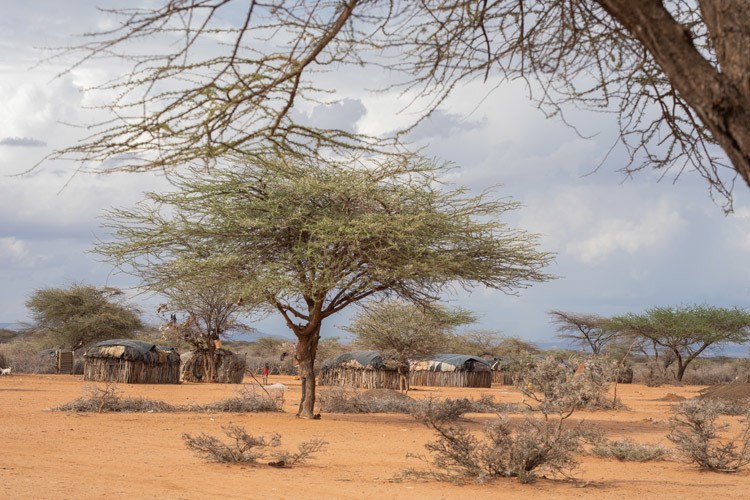
It’s a relentlessly sunny day in Isiolo County, Kenya, and a few hundred villagers are gathered under an acacia tree, its leafless branches so dense they still provide shade. Set against the dusty, beige landscape, the women’s beads are an oasis of vibrant color. They’ve come from across Lengurma — a sprawling network of communities of Indigenous Samburu people, four hours from the nearest town — to discuss what’s on everyone’s mind: the future of their land.
An extreme drought has killed off many of this community’s goats and cattle and dried up their local wells — but their ancestral land is also under threat from their own government. In the last few years, the Kenyan government began planning major development projects across their grazing lands without consulting the Samburu people who live here. What’s more, local authorities have halted the communities’ attempts to legally register as owners of the land they’ve lived on for generations.
Enter Samburu Women’s Trust (SWT) — a longtime AJWS grantee founded by Indigenous women to champion the human rights of Indigenous communities. SWT is the reason these villagers have gathered under the acacia tree.
SWT’s Head of Programs John Leparsanti steps to the front of the crowd with a simple message: We will not abandon you, and we’ll keep fighting together.

This message is the core of SWT’s work. The organization was founded in 2009, established by local Samburu leaders, to promote a whole spectrum of human rights — issues from within these communities, as well as challenges coming from the government. In addition to leading communities to defend their land, SWT guides Samburu people in the fight against female genital mutilation, which remains common in Samburu villages; the fight for women to hold leadership positions and make decisions in their own communities; and the fight for public institutions like schools and hospitals that are afforded to more populated areas. And they center women in all of these struggles.
“Each and every opportunity we get to empower women, we take it. Mentorship, workshops, trainings, educating girls as young as 9 about their basic human rights,” says Rufina Rhoda, an SWT project officer. “When they are given the knowledge, they can stand up and say ‘No.’ But if you don’t know your rights, you don’t know that you can say ‘No.’”
And the people of Lengurma, faced with a government plan to crisscross their land with highways and pipelines, are boldly saying “No.”

“You don’t know if your children will live here even tomorrow.”
At 30, Nolmeki Lensharu is a young leader in Lengurma, her children too young to understand the challenges their community faces.
“Our children deserve to own their family’s land legally,” she says. “You don’t know if your children will live here even tomorrow. We could be evicted at any time.”
Community elders can recall a simpler time, before the government began encroaching on their land and before climate change threatened their survival. Here in rural, Northern Kenya, about 2,500 Samburu people live as they have for generations — herding and grazing goats, living mostly nomadic lifestyles. Unmarried men, called morans, live and sleep in the bush, leaving the villages populated by women and Samburu elders.
But in 2016, everything changed: Kenya’s Community Land Act required Indigenous communities to obtain legal titles to their land — a complex and difficult process. Without this title, the government could develop Indigenous land at will. SWT stepped in, and guided Lengurma’s leaders to meet all government requirements: create community bylaws, register every member and complete all necessary paperwork. They submitted the application to the local government and then — nothing.

It’s been over two years now since SWT completed Lengurma’s registration process, and the government has not yet processed the application. In the meantime, major development plans are in the works, part of East Africa’s international LAPSSET Corridor project: an oil pipeline bisecting Lengurma; an artificial lake and a dam; and a highway leading to a resort city. All of these projects were plotted without any consultation with these communities. Local Samburus have done everything right — filed every document. But the government won’t acknowledge their rights to this ancestral land.
“The 2016 law could be so beneficial for Indigenous communities,” says John. “The law could provide an avenue for our communities to legally manage our own ancestral land. This law has a good aim, but our leaders are sabotaging what should be a victory. So we must keep pushing, keep fighting.”
Lemundirioni Lemuruasi, 85, is one of Lengurma’s oldest residents. He wears a t-shirt that says ”All Human, All Equal,” and he wants his community treated as such.
“When we speak about this land, it’s something we truly love. We know what we have here. Everything we have comes from this land, and we thank SWT for guiding us and helping us with the registration,” he says. “We stand together, and we’ll work together for as long as it takes. We’re holding on to hope. We refuse to give up. We’ll never tire of this fight. Just like the acacia tree at the center of our village will not move – neither will we.”

“There is no one left out in this community”
The drought that stretches across East Africa is among the worst of living memory for the elders of Lengurma. SWT has worked tirelessly to support the community, and the many others spread throughout Samburu County, to survive in resilient ways.
They’ve distributed critical food aid and cash transfers to families in desperate need, as well as supplies that families in distress would otherwise be unable to afford, like feminine hygiene products. SWT has also supplied these historically pastoral families with colorful beads — giving them a jumpstart to create beadwork that they can sell in nearby markets, thereby creating an alternative source of income. As some wells have dried up, SWT has helped villagers rehabilitate dilapidated sources of water.
For the Samburu people of Lengurma, both the fight for land ownership and the ongoing drought can feel like unmoving challenges. But the women of Lengurma are quick to speak about one issue where they have seen movement: gender equality.
For years, SWT has worked with Samburu communities to shift patriarchal attitudes and bring women into the decision-making fold. With resources stretched so thin these days, it’s more important than ever that everyone in the village gets a voice. And thanks to SWT’s efforts, increasingly they are.

Matito Leruso is another village elder, a woman who has watched proudly as Lengurma’s gender roles have begun to shift.
“Men and women may not have the same energy; we may not be the same. But today, a man can’t do something without consulting his wife. It’s not like it was before. A man must ask — he cannot tell,” she says. “Everyone deserves their human rights. A wife has the right to make decisions over our land just like her husband. And our names are on those land registration documents. There is no one left out in this community, including children. We will soon own this land.”

Under the acacia tree at the center of Lengurma, as John finishes his encouraging presentation to the community, something strange happens. Suddenly, dark, billowing clouds appear, blocking out the sun. A minute later, it’s pouring. Villagers run into their homes for shelter. The downpour only lasts a few minutes before the sky clears and a rainbow arcs over the land.
As the sun emerges again, women form a circle near the acacia and begin to dance and sing — praise for a few moments of relief from the brutal drought, and a symbol of hope that one day, with enough patience, support and dedication, these struggles will end.








